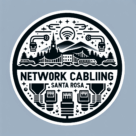Which Is Better RJ45 or CAT6? Understanding Ethernet Connections
If you’re upgrading your network, you’ve probably seen the terms RJ45 and CAT6 thrown around. Many people wonder, “Which is better, RJ45 or CAT6?” While these terms are related, they refer to different parts of your network setup. Understanding the difference can help you choose the right cables and connectors for your home or business network. Our team of structured cabling professionals in Santa Rosa ensures every installation uses high-quality cables and connectors for maximum network performance.
What Is RJ45?
RJ45 is a type of connector commonly used for Ethernet cables. You’ll see it at the ends of CAT5, CAT5e, CAT6, and CAT6a cables. Think of RJ45 as the plug that connects your cable to a router, switch, or computer.
Key points about RJ45:
- Standard 8-pin connector for Ethernet networks
- Compatible with most twisted-pair cables (Cat5e, Cat6, Cat6a)
- Supports speeds up to 10 Gbps, depending on the cable type
- Provides reliable connectivity for wired networks
RJ45 connectors are essential for terminating Ethernet cables and establishing a proper network connection.
What Is CAT6?
CAT6 (Category 6) is a type of Ethernet cable designed for high-speed data transmission. It’s one of the most popular choices for modern home and business networks because it offers faster speeds and less interference than older cable types.
Key points about CAT6:
- Supports speeds up to 10 Gbps over shorter distances (up to 55 meters)
- Bandwidth up to 250 MHz
- Reduces crosstalk and interference
- Backward compatible with CAT5 and CAT5e systems
- Ideal for VoIP, streaming, gaming, and cloud applications
If you’re setting up a wireless access point, you might wonder which cable is used for WiFi to ensure stable performance.
RJ45 vs. CAT6: What’s the Difference?
Many people get confused because they think RJ45 and CAT6 are the same. Here’s the difference:
| Feature | RJ45 | CAT6 |
|---|---|---|
| Type | Connector | Cable |
| Function | Connects devices to network | Transmits data over network |
| Speed | Depends on cable it’s attached to | Up to 10 Gbps |
| Compatibility | Works with CAT5e, CAT6, CAT6a | Uses RJ45 connectors |
| Usage | Ethernet ports, switches, routers | Network wiring for homes/offices |
In short, RJ45 is the plug, and CAT6 is the cable. You need both for a functioning network.
Which One Should You Choose?
Since RJ45 connectors are compatible with multiple cable types, the real choice is about cable performance:
- If you’re building a modern network with high-speed internet, CAT6 is the better option. It’s faster, reduces interference, and is more future-proof.
- RJ45 connectors are necessary no matter what cable you choose. Make sure to use high-quality RJ45 connectors rated for CAT6 if you want to get the most out of your network.
Why Professional Installation Matters
Proper installation ensures your CAT6 cable and RJ45 connectors work together efficiently. Certified installers:
- Ensure cables are properly terminated
- Test network speed and signal quality
- Maintain compliance with building and safety codes
- Avoid common mistakes like improper pinouts or over-tightened cables
Even a small error during installation can reduce network performance, so professional setup is highly recommended. Before deciding which connector or cable is best, it helps to know the maximum speed of Ethernet supported by your setup.
Upgrade Your Network Today
If you’re still using older cables or connectors, now is the perfect time to upgrade. Using CAT6 cables with RJ45 connectors ensures a fast, stable, and reliable connection for your home or business. Professional installation guarantees that your network performs at peak efficiency and is ready for future technology upgrades.
